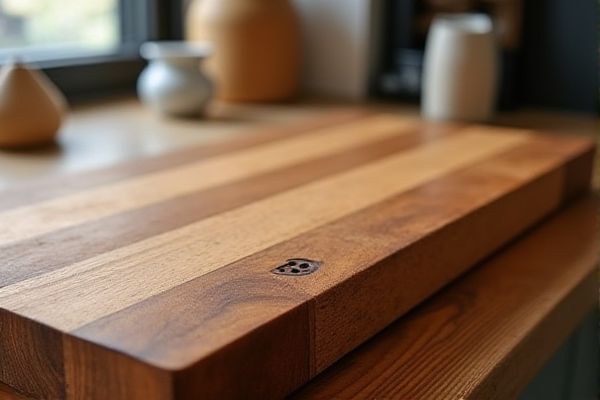
End-grain cutting boards showcase durability and knife-friendly surfaces by aligning wood fibers vertically, reducing wear and preserving blade sharpness. Explore this article to discover which cutting board suits your kitchen needs best.
Table of Comparison
| Feature | End-Grain Cutting Board | Edge-Grain Cutting Board |
|---|---|---|
| Grain Orientation | Wood fibers oriented vertically (end of the grain facing up) | Wood fibers oriented horizontally (side of the grain facing up) |
| Durability | Highly durable and self-healing surface | Less durable, more prone to knife marks and wear |
| Knife Friendliness | Gentle on knives; minimal dulling | More abrasive; dulls knives faster |
| Maintenance | Requires regular oiling and occasional sanding | Requires regular oiling but less frequent sanding |
| Price | Higher price due to complex construction | More affordable and easier to manufacture |
| Appearance | Unique checkerboard pattern | Classic linear wood grain look |
| Weight | Generally heavier and thicker | Usually lighter and thinner |
Introduction to Cutting Board Grains
End-grain cutting boards feature wood fibers oriented vertically, providing a durable, self-healing surface ideal for heavy chopping. Edge-grain cutting boards display horizontal wood fibers, creating a smoother, more affordable option suited for lighter kitchen tasks. The grain orientation affects knife longevity, board maintenance, and overall cutting performance.
What is End-Grain?
End-grain refers to the orientation of wood fibers on a cutting board where the grain runs vertically, exposing the wood's cross-section. This structure allows knife blades to slide between the fibers, reducing dulling and providing a self-healing surface that minimizes visible cuts. End-grain boards are often praised for their durability and gentle impact on knives compared to edge-grain boards, where the wood fibers run parallel to the cutting surface.
What is Edge-Grain?
Edge-grain cutting boards are crafted by aligning the long edges of wood strips vertically side by side, creating a flat, durable surface with visible grain lines running lengthwise. This construction offers a sturdy, knife-friendly surface that resists warping and is typically more affordable than end-grain boards. Edge-grain boards are popular in kitchens for their balance of durability, ease of maintenance, and aesthetic appeal.
Visual Differences: End-Grain vs Edge-Grain
End-grain cutting boards display a checkerboard pattern made by the wood fibers' cross-sections, revealing the tree's growth rings and creating a visually intricate design. Edge-grain boards have parallel wood strips running lengthwise, offering a more uniform, linear appearance with visible grain lines. Choosing between end-grain and edge-grain boards can impact the aesthetic appeal of your kitchen due to these distinct visual differences.
Durability and Knife Friendliness Comparison
End-grain cutting boards offer superior durability due to wood fibers oriented vertically, allowing self-healing from knife cuts and reducing blade wear over time. Edge-grain boards, with fibers aligned horizontally, tend to show knife marks more quickly and may dull blades faster because of the harder surface impact. Choosing end-grain boards enhances your cutting experience by preserving both the board's longevity and your knife's sharpness.
Maintenance and Cleaning Requirements
End-grain cutting boards require more frequent oiling and careful drying to prevent cracking due to their porous surface, making regular maintenance essential. Edge-grain boards are easier to clean and maintain, with less absorption of liquids and fewer knife marks, resulting in a lower risk of bacterial buildup. You should sanitize both types properly after use to ensure longevity and food safety.
Price and Value Considerations
End-grain cutting boards typically carry a higher price due to the labor-intensive construction and durable materials used, offering superior knife preservation and longevity. Edge-grain boards are more affordable and lightweight but may wear faster, requiring replacement sooner, which affects long-term value. Choosing between the two depends on balancing upfront cost against durability and maintenance needs for optimal kitchen investment.
Best Uses for End-Grain Boards
End-grain cutting boards excel for heavy-duty chopping and knife-intensive tasks because their wood fibers absorb impact, preserving blade sharpness and extending knife life. Known for durability and self-healing properties, end-grain boards resist deep cuts and maintain a smooth surface, ideal for professional chefs and home cooks who prioritize longevity. Your kitchen benefits from their robust construction, making them perfect for frequent use with sharp knives and frequent food preparation.
Ideal Applications for Edge-Grain Boards
Edge-grain cutting boards are ideal for everyday kitchen tasks such as slicing fruits, vegetables, and boneless meats due to their balanced hardness and resistance to knife marks. Their construction, featuring wood fibers running parallel to the surface, provides a durable yet gentle cutting surface that helps maintain knife sharpness. These boards are often preferred for their affordability and versatility in handling a wide range of food preparation needs.
Choosing the Right Cutting Board for Your Kitchen
End-grain cutting boards, made from wood fibers oriented vertically, offer superior durability and self-healing properties, making them ideal for heavy chopping and preserving knife sharpness. Edge-grain boards, constructed with horizontal wood fibers, provide a more affordable and stable surface suited for light to medium-duty cutting tasks. Selecting the right cutting board involves balancing factors like durability, maintenance, budget, and cutting style to enhance kitchen efficiency and protect your knives.
 homyna.com
homyna.com